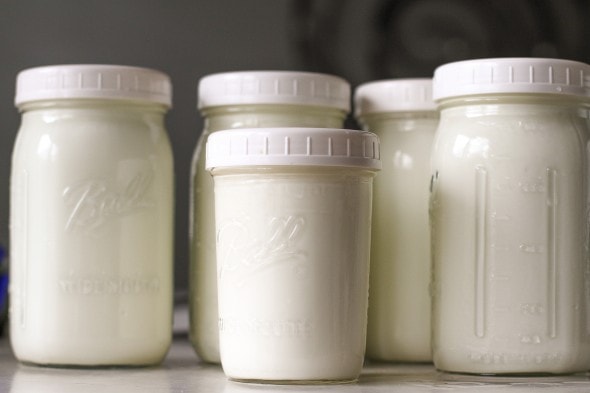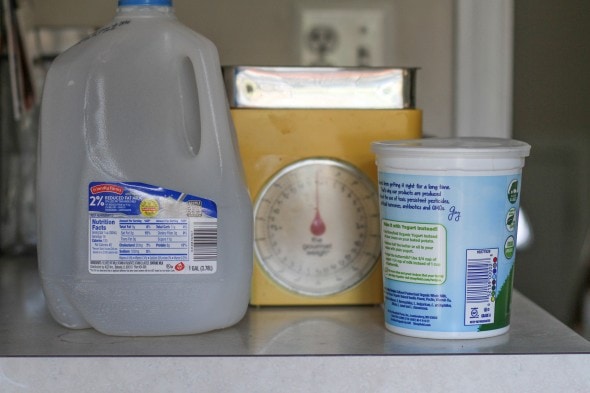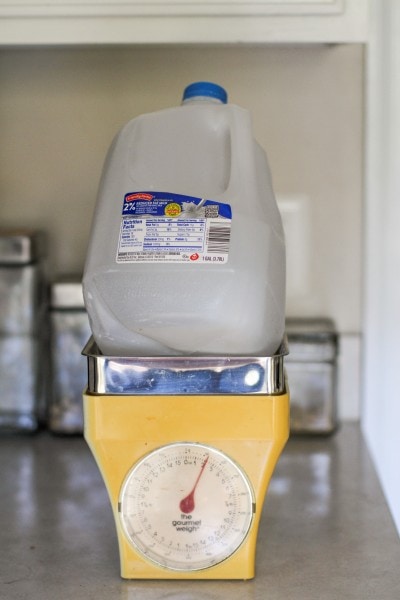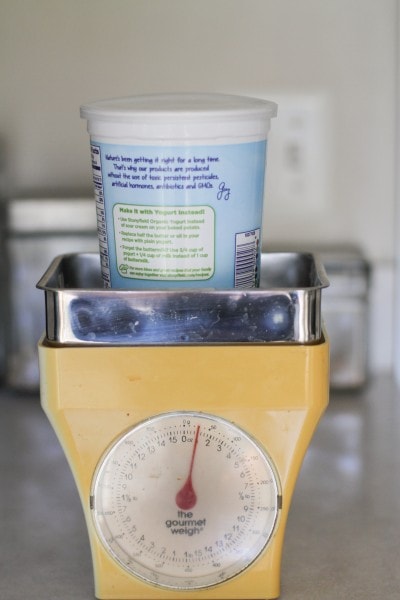This is a small thing I’ve wondered about for years, but never figured out!
So, I know quarts of homemade yogurt are definitely less trash-producing than individual cups of yogurt.

And I know my homemade yogurt is WAY cheaper than anything I can buy at the store.
(For instance, if you pay $4 for a gallon of milk, your yogurt quarts will be $1 each.)
But I’ve never been quite sure if the plastic from a gallon of milk is less than the plastic from four plastic quart containers of yogurt.

I needed a new starter last week (after 6-9 months or so, I seem to need a refresh), so I had the perfect opportunity to settle this question.
(Which, in the grand scheme of things, is not an enormous deal. I know. It’s just the kind of minutiae that I wonder about!)
As it turns out, an empty gallon container weighs 2 ounces.

And an empty quart container weighs 1 ounce.

So, a gallon (4 quarts) of store-bought yogurt requires 4 ounces of plastic, whereas a gallon of homemade yogurt requires 2 ounces of plastic.
And now I don’t have to wonder about this anymore. 😉
I’d have kept making homemade yogurt regardless of the outcome of this experiment, just because it’s so affordable and so tasty (I love how mild it is). But hey, it’s nice to know that it’s also slightly less trash-producing than store-bought yogurt.
P.S. Of course, if I got my milk in returnable glass jars, the homemade yogurt would be trashless. But there’s not a simple, nearby way to get milk in glass jars, so plastic gallons it is.
P.P.S. I use whole milk to make my yogurt every single time (it makes for creamier and thicker yogurt). But a 2% jug is what I had around when I took these photos.
P.P.P.S. Here’s why I don’t think you have to make yogurt.
P.P.P.P.S. Here’s how you make homemade yogurt (no special equipment required). And here are answers to common questions about homemade yogurt.
https://www.thefrugalgirl.com/2016/10/im-getting-a-nose-job-and-its-going-to-save-me-money/

Ally
Friday 18th of November 2016
I read your site religiously, but never comment - felt the need to for this one as it just cracked me up and warmed my heart in the mess that is 2016, so thank you for that <3. It's such a tiny question in the grand scheme of things, but I bet it's one that's been bugging you every time you make yoghurt, and I can only imagine that it feels sooo good to finally know!
Keep on doing you, and hope you recover from your surgery well & quickly x
Kristen
Friday 18th of November 2016
I'm glad it made you chuckle! And yes, it IS sort of delightful to know the answer to this not-so-pressing question. ;)
Barbara Ferguson
Wednesday 16th of November 2016
I make yogurt in 1 c. jars. I'm the only one eating it. Three years ago I started saving milk jugs in Sept. to make Halloween luminarias to put out with battery tea lights in them. Plenty of free outlines for carving purposes online. Just have to rethink what gets cut and what stays. I tape them on with clear packing tape. They store in a shed (no batteries) in a plastic trash bag rather well. Added some more last year and this year. Just had to replace dead batteries. I cut a hole in the side with the label to put my hand through. And they do need something to weight them down. Rocks work. But I recycled heavy springs taken off of pool cover and put two in each jug. Double recycling! The springs aren't wanted by recyclers.
Carol Gillen
Wednesday 16th of November 2016
I feel so lucky to get milk delivered from a local dairy in glass bottles. Yes, it is definitely more costly, but that's a place where I'm willing to spend more to get a high quality, sustainable alternative. Also, the plus of never running out of milk. Glad you are on the road to recovery. Your meds with the Tiffany blue bow gave me a smile this morning.
Janknitz
Tuesday 15th of November 2016
I've recently had to admit I'm not tolerating dairy very well, and I missed yogurt. I can handle coconut yogurt, but that's REALLY expensive and full of awful additives when you buy commercial coconut yogurt.
Fortunately, I found an easy way to make it at home. My Instant Pot electric pressure cooker has a yogurt making cycle (but you could use any other method to incubate it just as you do for dairy yogurt). Coconut milk does not require preheating to denature the proteins as dairy milk does. I just add culture to room temperature coconut milk, and incubate it for 12 hours in the Instant Pot which maintains an ideal temperature.
This is even more frugal if you make your own coconut milk from dried coconut flakes (and you get a bonus of coconut pulp which can be dried and ground into coconut "flour"). And if you bring your own reusable bag to buy the dried coconut in bulk . . .
(Shades of "If You Give a Moose a Muffin")
JD
Wednesday 16th of November 2016
This isn't the answer for everyone by any means, but I found that I had grown to be lactose intolerant, although I could still eat yogurt and cheese. When I switched to raw milk from a reputable local farm, I stopped having any problem with milk and drink it with no problem at all now. My daughter's boyfriend can't handle any kind of cow's milk and I've wondered about using coconut milk for him for ice cream and yogurt -- I'm glad to hear it can be done!
amanda
Tuesday 15th of November 2016
I would add too that milk jugs are recyclable, but in our area at least, yogurt containers only recently became recyclable.
That said, I don't eat that much yogurt, and try as I might, I couldn't get the recipe to work anyway.